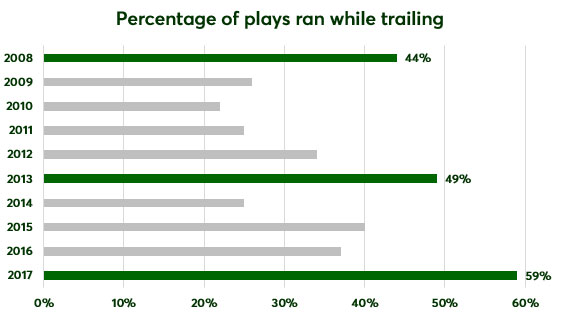Why Haven't the Packers Run the Football More?
General manager Ted Thompson and the Packers front office made restocking the cupboard at running back a top priority in the draft this past offseason, drafting Jamaal Williams, Aaron Jones and Devante Mays.
Ty Montgomery officially shifted from wide receiver to running back, too. When training camp started, there was the most optimism surrounding the position group since Eddie Lacy’s sophomore campaign in 2014.
However, the Packers rushing attack through fourteen games hasn’t made much of a statistical improvement in 2017. Green Bay is on pace for 1,723 rushing yards this season, barely more than the ragtag group of running backs in 2016.
If you put the stats aside and watch the games, the running game has been one of the biggest bright spots for this year’s Packers. Jones and Williams are the only two rookie running backs with over 400 yards in the NFL this season, and Williams almost single-handedly carried the team to wins while Aaron Rodgers was sidelined.
Why hasn’t the running game had more statistical success this season? Let’s dig into the numbers and find out.
Rodgers’ absence has hurt the running game more than you think
If you’re trailing in a game, it’s a pretty good bet that you’re more likely to pass the ball instead of run it. Because Aaron Rodgers is a great quarterback, the Packers don’t trail in a game very often.
Since Rodgers was named the starting quarterback in 2008, the Packers have ran just 36 percent of their plays on offense when trailing.
Let’s examine the three seasons where the Packers have struggled the most: 2008 (Rodgers’ first season as starter), 2013 (Rodgers’ first collarbone injury) and 2017 (Rodgers’ second collarbone injury). Green Bay has ran at least 44 percent of their plays while trailing in each of these three seasons:
With Rodgers on the sidelines or during his first season as starter, the Packers have ran an average of 182 more plays when trailing:
Considering an average NFL game features about 60 offensive plays for each team, that’s three full games.
Now that we’ve established the Packers are running more plays when trailing without Rodgers, how likely are the Packers to run the ball when they’re losing?
The Packers have trailed for 59 percent of their offensive snaps this season, and that’s had a tremendous impact on their rushing game. Even with two games to play, the Packers already have ran more plays when trailing than any other season under head coach Mike McCarthy.
Aaron Rodgers’ absence this season has meant the Packers have trailed more often in games, likely costing the running game approximately 50 to 60 carries.
Surprisingly, McCarthy hasn’t adjusted his playcalling strategy when trailing as he did in both Rodgers’ first year and 2013. In those seasons, the Packers ran the ball 40 percent of the time when losing.
This year, McCarthy has stayed at 36 percent, a single percentage point above his average during Rodgers’ tenure.
It’s hard to find an explanation for why McCarthy hasn’t leaned more on the running game when behind this season. It’s not as if he doesn’t trust rookie running backs – Eddie Lacy was a rookie in 2013. If anything, McCarthy feels confident in backup Brett Hundley’s game to not feel a need to lean more on the running game.
As we’ll discover below, the running game’s been a burgeoning success this season and deserves more opportunities and praise.
Green Bay’s rookies have made the most of their opportunities
Over the season’s first three contests, Aaron Jones didn’t touch the ball and Jamaal Williams rushed five times for 21 yards. Ty Montgomery was both the primary and secondary running back to start the season as the rookies adjusted to life in the NFL.
One of the advanced stats we provide at The Power Sweep is Run Percentage. The concept is straightforward, as it shows the likelihood a rush will go for 0 or fewer yards, 1-4 yards, 5-9 yards, 10-19 yards, or more than 20 yards.
In 2016, the Packers running game was not especially dynamic. Below-average or average carries (four or fewer yards) accounted for 64 percent of all 2016 rushing attempts. This season, just 59 percent of all rushes have gone for four or fewer yards.
Jones has established himself as a big play running back. In only 78 carries, he’s rushed for over 20 yards once every 12 attempts. Even Montgomery’s breakout 2016 campaign which featured a slew of memorable long runs can’t match that rate.
The impact Jones and his counterpart Williams have had on the running game in their limited opportunities has made a tremendous difference to the Packers offense. As a result, Green Bay enters Saturday night’s game against the Vikings as the sixth-best rushing attack on a per carry average.
Rushing yards per play, top 6 NFL teams entering Week 16
When Aaron Rodgers is at full strength next season, it’s clear the Packers will have one of the league’s best rushing attacks at his disposal.







